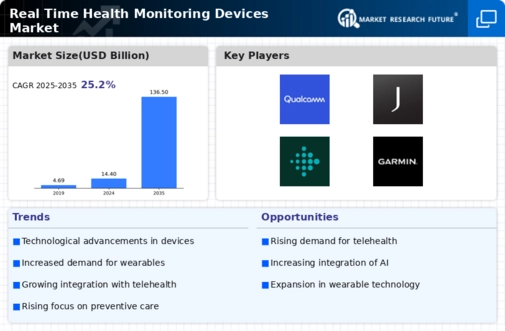Leading market players are investing heavily in research and development in order to expand their product lines, which will help the Real Time Health Monitoring Devices Market, grow even more. Market participants are also undertaking a variety of strategic activities to expand their footprint, with important market developments including new product launches, contractual agreements, mergers and acquisitions, higher investments, and collaboration with other organizations. To expand and survive in a more competitive and rising market climate, Real Time Health Monitoring Devicesindustry must offer cost-effective items.
Manufacturing locally to minimize operational costs is one of the key business tactics used by manufacturers in the Real Time Health Monitoring Devices industry to benefit clients and increase the market sector. In recent years, the Real Time Health Monitoring Devicesindustry has offered some of the most significant advantages to medicine.
Major players in the Real Time Health Monitoring Devices Market, including GE Healthcare (U.K.), Qualcomm (U.S.), Jawbone Inc. (U.S.), Withings SA (France), Fitbit Inc. (U.S.), Garmin Ltd. (Switzerland), and others, are attempting to increase market demand by investing in research and development operations.
Qualcomm is known for developing innovations that push the boundaries of what's possible across devices and networks to enable next-generation experiences and drive digital transformation across industries. Decades of extensive research fuels every one of our extraordinary inventions and our one technology roadmap allows us to efficiently scale our portfolio of industry- leading mobile innovations to support virtually every device connected to the cloud.
Goldman Sachs predicts that generative Al could raise GDP by almost $7 trillion over a 10-year period. Hybrid Al, which distributes processing between the device and the cloud, is a key part of achieving this growth across the economy. On-device Al processing offers many benefits, including user privacy, security, immediacy, enhanced reliability, and cost. The pace, scale, and high integration that drive the mobile industry are allowing Al to scale to billions of devices. The power-efficient Al technology that we research and develop is fundamental across industries and products, spanning from smart phones, PCs, and XR to loT and automotive.
Jawbone is a 460MW onshore wind power project located in Montana, United States. It is being developed by Gaelectric LLC; Seventus LLC. The project is currently under construction. The project is expected to enter commercial operation in 2023. The project is owned by Gaelectric LLC; Seventus LLC. Jawbone profile includes core details such as plant name, technology, capacity, status, plant proponents (owners, developers, etc.), owner stakes, etc as well as key operational data including generation, year online, decommissioning year, capital expenditure, etc.
Details on project-specific contacts along with relevant news, deals, and contracts are also provided through the plant profile. This is an on-demand report that will be delivered upon request. The report will be delivered within 1 business day of the purchase, excluding weekends and holidays. Certain sections of the report may be removed or altered based on data availability and relevance.

















Leave a Comment